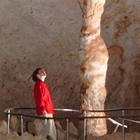Let’s get buggy
Bug hunting is a great way to enjoy some time with your grandchildren.

Children seem to be fascinated by bugs, or is it just the dirt that attracts them? Either way, there is another activity to occupy your grandkids when they are with you in your RV. Here are some basic facts about bugs, and maybe some insight into why children are fascinated by them.
Insects are invertebrates (animals without a backbone). Some bugs suck the life out of their prey.
Some bugs have great names like the assassin bug. Three types of assassin bugs are spotted, spined and leafhopper. These names alone can make you want to investigate the creatures. How about the Western bloodsucking conenose, the tarnished plant bug and the stilt bug? Then there is the stink bug—gives you pause. It is a plant eater that can produce a foul smelling fluid to deter predators. The Pacific ambush bug and the ant-mimic bug also seem to beg for more information. The small Eastern milkweed bug, Lygaeus kalmii, hibernates in plant debris, small logs or in houses. It is found throughout the US, anywhere that milkweed grows, such as fields and meadows.
Now that your grandchildren have learned about these interesting creatures, they can become "junior entomologists."
How to become a junior entomologist:
Get your entomology kit and let’s find those bugs. An entomology kit consists of:
- Clean, clear glass jar with lid
- Magnifying lens
- Bug hat
- Gloves
- An adult who knows what NOT to touch
- Pencil and paper
- Camera
- Clothing suitable to the weather—long sleeves, long pants and shoes, not sandals
- Sunscreen lotion
- A good insect field guide
For starters, let’s hunt the assassin bug. Do not touch this bug. It can cause a painful bite. It is about one inch long and has yellow stripes. Look in your field guide to find where the assassin bug hangs out and what it looks like.
Next, the stink bug—hold your nose! (just kidding). This bug is about ¾ of an inch long, feeds on plants and will emit a nasty odour if disturbed. It can be found on or near many plants.
When you find a bug, study it. Write all the details down and pretend you are going to have to describe it to someone who has never seen a bug. How big is it? Is it hard or soft? Where did you find it? Look at the colour, any distinguishing marks, mouthparts, number of legs. Turn it over, gently, and study it. If you have a camera, take a picture. Now put it back where you found it and look for another type.
Don’t forget to look in water—a pond will do nicely. Pond skaters can be found on the surface. They use their long skinny legs to walk on water in search of food. Can you find any of these types of bugs in your pond?
When you can identify three different bugs and have written your findings up, you can consider yourself a junior entomologist. Keep investigating and add to your findings. Good hunting.
Make your own bug hat
This is a protective screen best worn over a hat that has a brim or a visor.
Materials:
- Fine mesh, about a yard, wide netting
- Felt (a small square)
- Elastic
- Button thread or doubled sewing thread
- Needle
Procedure
- Cut a piece of netting 25 x 45 inches.
- Make a one-inch hem along one of the long edges.
- Attach a piece of elastic to the end of the hem and draw the elastic through the opening using a safety pin to ease it through. Your grandkid can do this part.
- Put the short edges together and stitch so that you have a circle.
- Gather the netting about half an inch down from the top of the circle, opposite the hem and, once you have stitched the whole way around, pull it firmly to close the circle. Knot the end.
- To wear the bug hat, pull it over a regular hat and you are good to go.
- Do not spray with insect repellant, as this will cause the netting to disintegrate.
- You can use essential oil in a mix of 5 parts peppermint or rosemary to one tablespoon of any type of carrier oil (such as olive or grapeseed oil for example). Smooth onto exposed skin. This will keep ticks away.
Note to parents and grandparents: When your child completes the above study, he or she is now a junior entomologist. We would be happy to send you a certificate if you would send us your email address.








